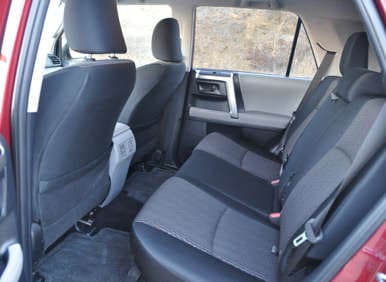Recent Articles
Popular Makes
Body Types
2012 Toyota 4Runner Road Test and Review
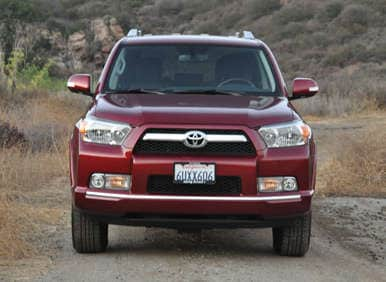
Built to tackle the toughest terrain found anywhere on Earth, the 2012 Toyota 4Runner is a traditional body-on-frame, midsize SUV. That means the 4Runner is old-school, a truck designed for serious hauling, towing, and off-roading.
Because it shares its underlying platform with the Lexus GX 460, the 4Runner is more refined than you might expect, but don’t take that to mean that this Toyota SUV is intended primarily for suburban family duty. Where the 4Runner excels is in places where concrete and blacktop are missing from the landscape, where deep snow is common, and where rocks threaten undercarriages.
Still, many people love the 4Runner for other reasons, myself included. The 4Runner is appealing for many of the same reasons a Jeep Wrangler is, equipped with a rugged, outdoorsy, masculine image and a reputation for bulletproof dependability. Plus, it’s a solution to the “what if?” question. For example, Southern Californians frequently ask themselves, “What if the Big One hits?” A BMW 3 Series won’t get your family out of L.A. if a massive quake strikes. But a 4Runner, which can forge its own path out of the destruction, could.
Besides, I just like to drive this Toyota along the beach with all the windows down and the sunroof open. It’s like a convertible or a Jeep Wrangler in that way, but without the pesky fabric roof.
2012 Toyota 4Runner Review: Pricing and Trim Levels
There are three versions of the 2012 Toyota 4Runner for sale. The standard model is called the SR5, the dedicated off-roader is called the Trail, and the luxury model is called the Limited.
The 4Runner SR5 ($31,090) is equipped with standard 17-inch aluminum wheels and skid plates, as well as heated outside mirrors with turn signal indicators and a wiper de-icer grid. Additional features include dark tinted privacy glass, power windows with automatic up/down functionality, power door locks with remote keyless entry, air conditioning with rear seat air vents, a tilt/telescopic steering wheel, and cruise control. Bluetooth hands-free calling and music streaming is also standard, and the eight-speaker sound system includes a USB/iPod connection as well as a “Party Mode” button that automatically adds bass and shifts the balance of sound to the rear liftgate speakers. A height-adjustable driver’s seat, a trip computer, a compass, an outside temperature display, and a Homelink universal remote are also included on every 4Runner SR5.
Options for the 4Runner SR5 include a sliding cargo deck can support 440 pounds and is useful for tailgate parties and managing heavy loads. The SR5 can also be upgraded with a power sunroof, leather upholstery, a third-row seat, automatic running boards, and a Display Audio system with navigation and Entune services.
If you’re planning serious off-road excursions, you’ll want to buy the 4Runner Trail model ($36,755). This version of the 4Runner is equipped with standard four-wheel drive, and includes both Multi-terrain Select and Crawl Control technologies. Additionally, the Trail model is equipped with an eight-way power driver’s seat, water-resistant fabric seats, upgraded gauges, an auto-dimming rearview mirror with a reversing camera, a sliding cargo deck, and a power sunroof. The only options are a Kinetic Dynamic Suspension System (KDSS) and a Display Audio system with navigation and Entune services.
The 4Runner Limited sits at the top of the lineup ($38,595). It comes standard with dual-zone automatic climate control, leather, heated front seats, Smart Key entry and push-button ignition, and the Display Audio system with navigation and Entune. Full-time four-wheel drive is also standard on the Limited model, along with an electronic X-REAS suspension. Extra-cost items include a sliding cargo deck, a third-row seat, automatic running boards, and a 15-speaker JBL premium audio system with navigation and a larger display screen.
All 4Runners are equipped with eight airbags, including knee airbags for the driver and front passenger. Traction control, stability control, and four-wheel ventilated-disc antilock brakes with electronic brake-force distribution and brake assist are also included, along with reverse sensing sonar. Safety Connect telematics with Automatic Crash Notification service is optional, and a reversing camera is optional on the 4Runner SR5 and standard on the Trail and Limited models.
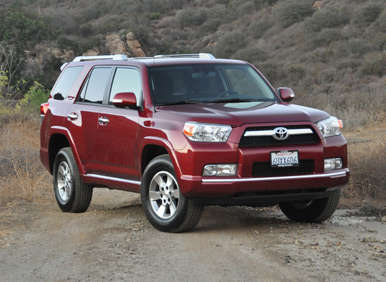
2012 Toyota 4Runner Review: What It’s Up Against
There was a time when most midsize sport-utility vehicles were rugged body-on-frame trucks capable of going farther off of a paved road surface than a typical car. They could tow. They could haul. And they were seriously overqualified for the assignments given to them by the typical American family.
Today, consumers favor the crossover suv, leaving traditional SUVs like the 4Runner to serve people who need genuine off-roading capability. As a result, the 4Runner’s list of direct competitors has dwindled to five nameplates: Jeep Grand Cherokee, Jeep Wrangler Unlimited, Nissan Pathfinder, Nissan Xterra, and Volkswagen Touareg.
Next year, the Pathfinder is transformed into a three-row family crossover, leaving just four credible competitors for the Toyota 4Runner.
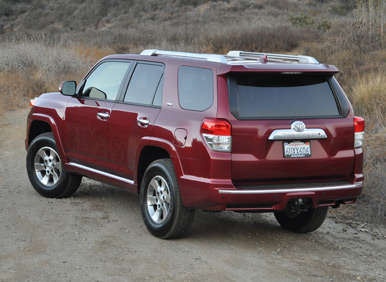
2012 Toyota 4Runner Review: Exterior
What’s New for 2012:
- Optional automatic running boards for SR5 and Limited models
How It Looks
Here’s a fun piece of trivia for the next gathering of the guys: the Toyota 4Runner, which resembles a brick on wheels, boasts a drag coefficient of 0.36. That’s less than what Chrysler reports for the new SRT Viper.
We test-drove the 4Runner SR5 with 4WD, pictured here in Salsa Red Pearl. Among the trifecta of 4Runner models, however, our favorite one is the Trail model. It swaps the SR5’s body-color exterior trim in favor of matte black detailing, adds a cool-looking hood scoop, and is equipped with special slotted 17-inch aluminum wheels. The Trail also features smoked headlight and taillight lenses, water-resistant interior fabric, and supplies superior approach and departure angles.
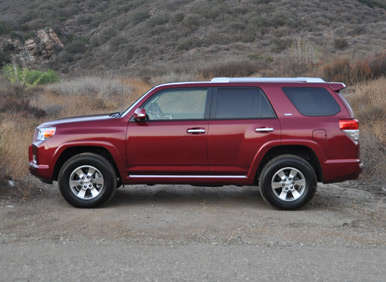
2012 Toyota 4Runner Review: Interior
What’s New for 2012:
- Standard Bluetooth hands-free calling and music streaming, satellite radio with free 90-day subscription, and USB/iPod connectivity
- New Display Audio touchscreen radio with navigation, text/e-mail to speech, HD Radio with iTunes tagging capability, and Toyota Entune services is standard on Limited and optional on SR5 and Trail models
- Toyota Entune includes three years of complimentary access to smartphone mobile applications and services through the Display Audio system
How It Looks and Feels
There’s a bit of a hose-out quality to the 4Runner’s interior plastics, but given this SUV’s mission to serve as a serious off-roader, the materials look and feel appropriate for the task at hand. More appealing is the fabric on the SR5’s seats, which are comfortable front and rear – once you’ve clambered aboard. Older adults and children may struggle to get into or out of a 4Runner without those new extra-cost automatic running boards.
Once seated, all occupants enjoy a commanding view out of the windows. My 4-year-old was really excited to ride in the 4Runner: “Daddy, I can see everything!” Toyota offers an optional third-row seat for seven-passenger capacity, but our test sample did not include this feature.
With the third-row seat installed, the 4Runner offers a scant 9 cu-ft. of cargo capacity, measured vertically. Basically, that seat sits flush against the liftgate. Without the third-row seat (or with it folded), the 4Runner provides up to 47.2 cu-ft. of space. Maximum cargo volume measures 89.7 cu-ft., and when folding the second-row seats to expand space you need not remove the headrests for them to collapse flat.
The 4Runner’s optional sliding rear cargo tray, I’m sure, is useful to somebody. I think it’s a bit of a gimmick, slightly reducing cargo space and certainly proving difficult to clean inside of all the nooks and crannies it creates. My bet is that some people also lose valuable items underneath this contraption.
Our sample came equipped with Toyota’s new Display Audio system, which features a rather small 6.1-inch screen susceptible to reflections and washout in direct sunlight. In the 4Runner, Display Audio is not as aggravating as some other Toyota models, because the power/volume knob, the tune/balance knob, and the six hard keys are large and easy to use. The radio station pre-set buttons and other functions on the screen itself? Not so much.
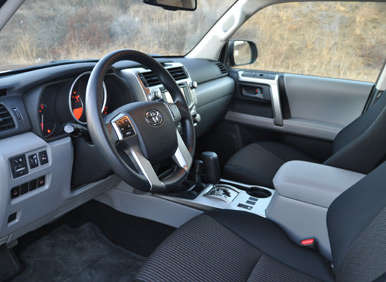
2012 Toyota 4Runner Review: Powertrain
What’s New for 2012:
- No changes
How Does It Go
Toyota installs a 4.0-liter V6 engine making 270 horsepower and 278 lb-ft. of torque into every 4Runner. The engine drives the rear or all four wheels through a five-speed automatic transmission, and all 4Runners are rated to get 19 mpg in combined driving. We averaged 18 mpg in our SR5 4WD test truck. The 4Runner is rated to tow up to 5,000 pounds and carry as much as 1,700 lbs. of payload when properly equipped, and Toyota covers all scheduled maintenance for the first two years or 25,000 miles of ownership.
We didn’t tow anything. We didn’t haul anything. And perhaps as a result, we were entirely satisfied with the 4Runner’s V6 engine. It had no trouble getting the heavy SUV up to speed, providing safe merges onto the freeway. It conquered the Camarillo Grade at a steady 80 mph, rising 1,000 feet in elevation in a matter of minutes. And it supplied plenty of torque for powering up a dirt hillside in Malibu.
All 4Runners have Hill-start Assist Control, which helped during our brief off-roading foray. Models with rear-wheel drive also get an automatic limited-slip rear differential for improved traction on slippery roads.
If you choose to get 4WD, the SR5 and Trail can be equipped with a part-time 4WD system with a manual transfer case shifter. The Limited model has full-time 4WD with a locking center differential. All 4WD models include Downhill Assist Control and Toyota’s A-TRAC traction control, which directs power to a single wheel in the event the other three are airborne. Additionally, the 4Runner Trail is equipped with a standard rear locking differential.
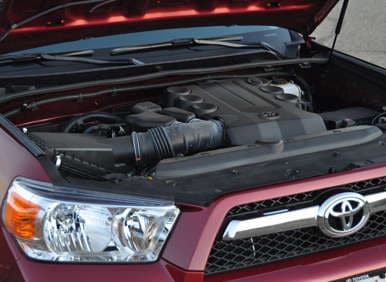
2012 Toyota 4Runner Review: How It Drives
In addition to the hardware outlined on the preceding page, the 4Runner rides on a double-wishbone front suspension, a four-link rear suspension, and features coil springs over gas shocks. Limited models have a standard X-REAS automatic damping suspension that electrically adjusts damping on bumps or when taking corners, cross-linking the shocks on opposing ends of the vehicle to counteract pitch and yaw for greater stability.
People buying the 4Runner Trail benefit from a Crawl Control feature in low range gear, which automatically regulates engine speed, engine output, and braking force according to one of five settings, allowing the driver to concentrate more on navigating and less on modulating the accelerator and brake pedals. Additionally, the 4Runner Trail is available with a Kinetic Dynamic Suspension System (KDSS), technology shared with the Lexus GX. The KDSS dynamically disconnects the 4Runner’s stabilizer bars for greater axle travel and better suspension articulation on difficult terrain.
The 4Runner SR5 has 17-inch wheels wrapped in 265/70R17 mud-and-snow tires, and provides nine inches of ground clearance. That’s with two-wheel drive. Add 4WD, and the 4Runner supplies 9.6 inches of space between the ground and the SUV. For the best off-road performance, the Trail model provides a 33-degree approach angle and 25-degree departure angle, compared to 25 degrees and 24 degrees, respectively, for other 4Runner 4WD models.
Off-road, the Toyota 4Runner is in its element. For this test, we didn’t toss much of a challenge the Runner’s way – taxing trails that are open to the public are few and far between in the Los Angeles area, and in August there is virtually no mud to be found. That said, we know from previous experience driving a 4Runner Trail model with the KDSS suspension that the ‘Yota is brilliant in the bush. Unstoppable even. Unless you do something monumentally stupid.
On pavement, the 4Runner drives like a truck, and with the SR5’s standard suspension this SUV exhibits plenty of roll, wallow, and pitch, depending on the road surface and how it is driven. You’re definitely aware of this SUV’s hefty 4,675-lb. curb weight, whether turning, cruising, or descending a grade, where the 4Runner easily picks up speed. The 70-series mud-and-snow tires don’t do the truck any favors when taking a hairpin turn, the steering is slow and fairly vague, and the brake pedal is rather soft and long in travel.
Still, those truck-tough underpinnings utterly crush bad roads into submission, and render the truck impervious to some road hazards. We rolled right over a rectangular chunk of metal on the freeway and aside from a shudder the 4Runner was unfazed.
This SUV proved surprisingly quiet on the highway when all the windows were rolled up, and terrific fun to drive with all the windows rolled down. Get one with the power sunroof, and the effect is not unlike that of a convertible.
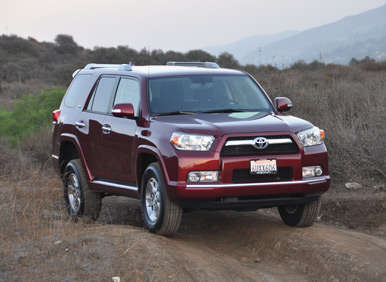
2012 Toyota 4Runner Review: Final Thoughts
Though I’m a person far more comfortable doing triple-digit speeds on a paved track than crawling at single-digit velocities on a mountainous two-track, I truly adore the Toyota 4Runner. I have almost zero use for its prodigious capabilities, yet I want to park one in my driveway. The Trail model, no less. Because one day, I just might need what the 4Runner Trail can deliver.
Part of the appeal relates to the “What if?” question. Plus, I’m a long-time convertible driver, and the 4Runner delivers the same wind-blown sensation combined with the security of a solid roof. Additionally, I often find that nearly 90 cu-ft. of cargo space is useful. And Toyota’s promise of long-term dependability certainly is a draw.
Besides, this Toyota got an instant stamp of approval from my daughter, who kept calling it a “Jeep.”
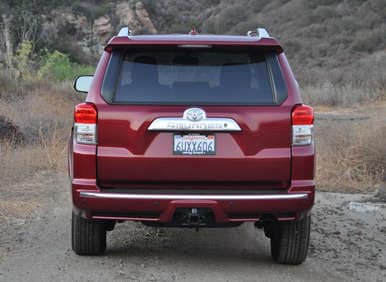
2012 Toyota 4Runner Review: Pros and Cons
Pros:
- Go anywhere, at anytime
- Comfortable front and second-row seats
- Convertible effect with windows down and sunroof open
- Crushes lousy roads into submission
- Quiet on the highway
Cons:
- Woozy on-pavement ride and handling
- Hard for some passengers to enter and exit
- Display Audio screen reflections, wash-out, tiny touchscreen buttons
- Average fuel economy of 18 mpg
Toyota provided the vehicle for this review
2012 Toyota 4Runner photos by Christian Wardlaw
